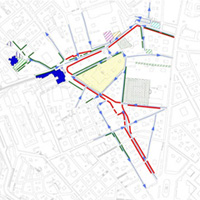Pedestrian routes and urban requalification: the Montesanto area in Naples
Abstract
This paper illustrates a project targeted to the recovery of the area of Montesanto, included in the historical city of Naples, through a route network devoted to a prevailing pedestrian use. At present, relevant urban equipments are located in the investigated area; moreover, this area represents one of the main junction of the urban railway network, the shunting point of relevant flows of users either towards the Greek-Roman part of the historical city or towards the directional area and the monumental core. Furthermore, in the above-said area, interventions addressed to the recovery of the Cumana station and of the square in front of the station have been recently carried out. The project proposal – which is part of a wider Plan for Protected Pedestrian Mobility in the historical city of Naples - aims at fostering the co-existence, under security conditions, between high intense pedestrian flows and car flows (local users and emergency accessibility), apart form assuring the implementation of a requalification process which, starting from the pedestrian network, would affect the overall area. In detail the proposal, grounding on in-depth analyses of the features both of the urban context and of the individual roads and squares to be included in the pedestrian network, provides some guidelines for the reorganization of the heterogeneous activities and flows along the network and for the consequent redefinition of its spatial features.Downloads

Copyright (c) 2014 Tema. Journal of Land Use, Mobility and Environment

This work is licensed under a Creative Commons Attribution 4.0 International License.
Authors who publish in this journal agree to the following:
1. Authors retain the rights to their work and give in to the journal the right of first publication of the work simultaneously licensed under a Creative Commons License - Attribution that allows others to share the work indicating the authorship and the initial publication in this journal.
2. Authors can adhere to other agreements of non-exclusive license for the distribution of the published version of the work (ex. To deposit it in an institutional repository or to publish it in a monography), provided to indicate that the document was first published in this journal.
3. Authors can distribute their work online (ex. In institutional repositories or in their website) prior to and during the submission process, as it can lead to productive exchanges and it can increase the quotations of the published work (See The Effect of Open Access)
